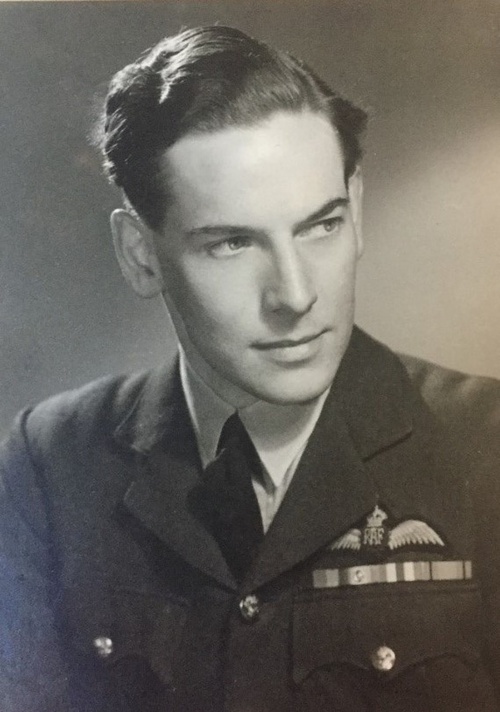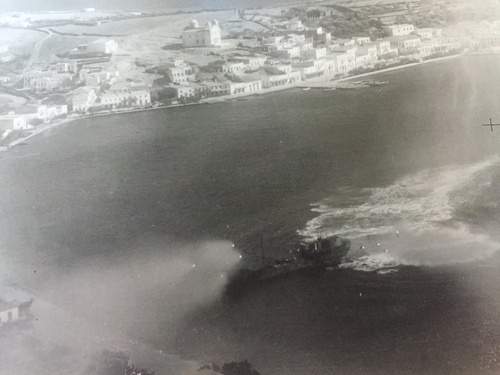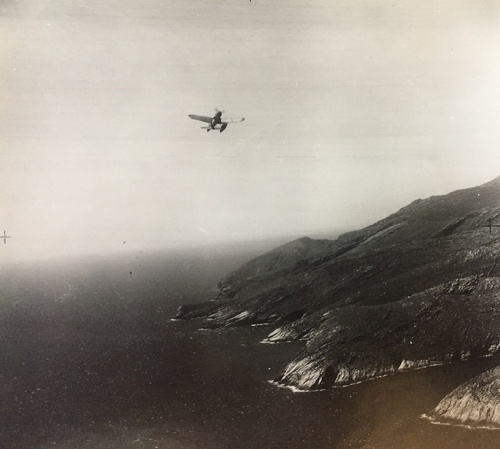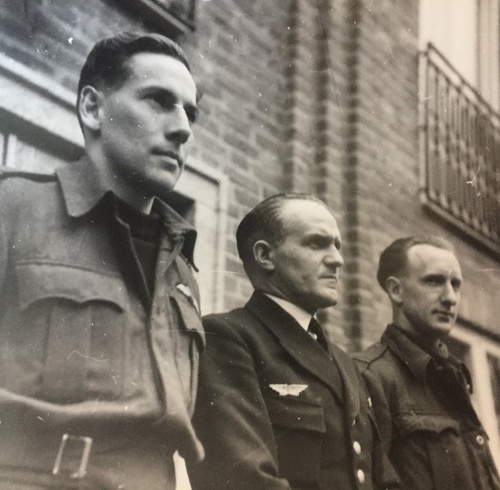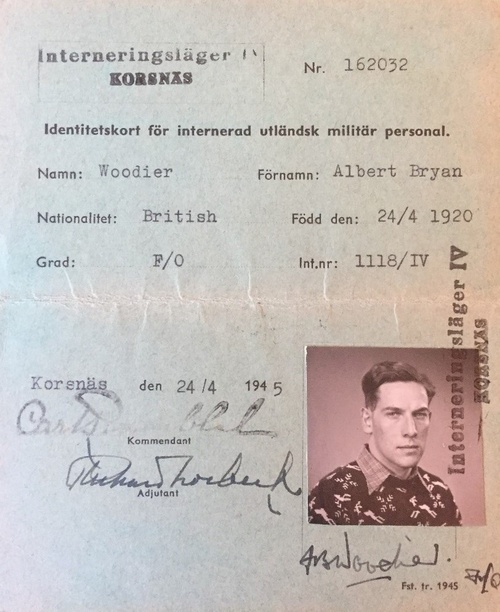Auction: 22003 - Orders, Decorations and Medals
Lot: 328
'We attacked across the sun. east to west, firing cannon, machine-guns and rockets. I then went low over the target in a shallow dive. There was a loud bang accompanied by intense vibration. The cockpit immediately filled with dense glycol fumes thick enough to obscure the instrument panel. I felt for the feathering buttons and fortunately pressed the right one! With the starboard propeller feathered, the glycol began to clear, but looking across to the starboard propeller, about 12 inches off one of the blades had been removed. Flying Officer Arthur Jones, my excellent navigator, gave me a course for Halmstad, Sweden, and then called up Junior, our WingCo, telling him what we were going to do. Thirty minutes later we landed at this small grass aerodrome … '
Flying Officer A. B. Woodier, a Mosquito pilot in the famous Banff Wing, recalls a close call over the Skagerrak on 19 April 1945; A Separate Little War, by Andrew D. Bird, refers.
An outstanding and well-documented Second World War pilot's campaign group of five awarded to Flying Officer A. B. Woodier, Royal Air Force Volunteer Reserve
Having cut his teeth in Beaufighter operations with No. 603 (City of Edinburgh) Squadron over the Aegean in the summer of 1944 - in which he gained membership of the Goldfish Club after being compelled to ditch his flak-damaged aircraft - he joined No. 235 Squadron and the famous Banff Wing in early 1945
As cited above, in a subsequent strike against U-boats and an enemy minesweeper in the Skagerrak on 19 April, his Mosquito was hit by flak in the starboard engine, thereby forcing him to undertake an emergency landing in neutral Sweden
1939-45 Star; Atlantic Star, clasp, France and Germany; Italy Star; Defence and War Medals 1939-45, mounted as worn, good very fine (5)
Albert Bryan Woodier was born in Runcorn, Cheshire on 24 April 1920 and attended Liverpool College.
As verified by accompanying archive material, he gained a proficiency certificate as a pupil in Liverpool University's Air Squadron in August 1942, the same month in which he joined the Royal Air Force Volunteer Reserve.
Embarked for South Africa in the hired transport Strathmore in February 1943, he undertook pilot training at Clairwood and elsewhere, and was awarded his 'Wings' and appointed a Flight Sergeant in December of the same year.
Baptism of fire - Beaufighters over the Aegean - in the drink
In April 1944, Woodier attended an Operational Training Unit in the Middle East, following which he joined the strength of No. 603 (City of Edinburgh) Squadron, a Beaufighter unit operating out of Gambut. Teaming-up with Sergeant Lee as his Navigator, he first flew operationally on a night intruder sortie over Maleme, Crete, at the end of August.
In September, the Squadron undertook a spate of anti-shipping strikes, Woodier participating in an attack off Cape Matapan on the 4th.
Two days later, in a similar sortie, his aircraft was attacked by an Arado 196 seaplane and, owing to resultant damage, he had to undertake a belly-landing back at base. An unusual opponent, the Acado 196 first made an impression in the Battle of Britain, when one such aircraft took-on six Spitfires and shot one of them down.
Back in action on the 9th, Woodier and his fellow pilots attacked an R-boat off Milos, forcing it to beach.
Then, on the 'unlucky 13th', in another offensive sweep, he was compelled to ditch his flak damaged Beaufighter in the sea. He and his navigator were eventually picked-up by a Walrus aircraft after four hours in their dinghy, a happy event that was captured on camera and reported in the press. Yet it was not until 1983 that Woodier applied for membership of the famous Goldfish Club, an application duly approved; accompanying correspondence refers.
Duly dried-out, pilot and navigator returned to the fray in October, including a 'Rover' patrol and further strikes off Leros. In early November, Woodier flew his final sortie with the Squadron, a recce over Leros-Cos-Rhodes.
Banff Wing - final fling - Swedish sojourn
Embarked for the U.K. - and commissioned as a Pilot Officer in February 1944 - Woodier next joined No. 235 Squadron, a Mosquito unit of the famous Banff Wing.
He flew his first sortie on the 5 March 1945, a strike on enemy shipping in Njorangs Fjord, in which four of our aircraft were engaged and shot down by Fw. 190s.
Inevitably, perhaps, Woodier's latest appointment was likewise about to come to a grinding halt. As cited above, he took-off for a strike against three U-boats and an enemy minesweeper in the Skagerrak on 19 April, but his Mosquito was hit by flak in the starboard engine over the target and he was compelled to carry out an emergency at Halmstad in neutral Sweden. Of subsequent events, he later recalled:'After one night in Halmstad, the Adjutant Commander Nilssen escorted us by train to Falum, where we were given money to buy civilian clothes and accommodated in a large house together with a number of Bomber Command crews who were awaiting repatriation. We caught up with one of our Mustang escort pilots, Stuart Pearson, who had also landed on the west coast of Sweden with engine trouble. After a week we transferred to a hotel in Stockholm for two nights, had a brief visit to the British Embassy, then shortly afterwards we flew back to Scotland in a B.O.A.C. Dakota. The we travelled to London for our debrief' (A Separate Little War, by Andrew D. Bird, refers).
Woodier was released from the R.A.F.V.R. in early 1946, but later served as a Flying Officer in No. 608 (North Riding) Squadron of the Royal Auxiliary Air Force in 1950-51.
He died at Frodsham, Cheshire in September 2008.
Sold with an extensive archive of original documentation and photographs, together with flying kit:
(i)
The recipient's South African Air Force (S.A.A.F.) Pilot's Flying Log Book (Form DD 461), being a complete record of his flying career, from May 1943 until January 1946, and his later service in the Royal Auxiliary Air Force in 1950-51.
(ii)
A file of documents relating to his application to join the R.A.F.V.R., including Liverpool University Air Squadron letter, together with R.A.F. Exercise Books (2), with early training notes.
(iii)
A fine array of operational air to ground / sea images from both of his operational tours, particularly targets in the Aegean (approx. 50 images), together with further selection of more general wartime photographs (approx. 30 images).
(iv)
A file of documents relating to his final sortie and emergency landing in neutral Sweden, including official telegrams and letters, one of the latter to his parents from his Squadron C.O., happily reporting him safe; together with his Swedish identity card, dated 24 April 1945, and two photographs of him and his navigator with Adjutant Commander Nilssen, who escorted them by train to Falum; and two Swedish newspapers.
(v)
His R.A.F. Service and Release Book, stamped at Uxbridge on 12 November 1945.
(vi)
Goldfish Club correspondence from 1983, concerning the recipient's application and acceptance, together with his embroidered membership badge and tie.
(vii)
His wartime identity discs.
(viii)
His Irvin fleece-lined, leather flying jacket, canvas flying helmet and leather gloves, together with three wartime period embroidered R.A.F. uniform 'Wings'.
Subject to 20% VAT on Buyer’s Premium. For more information please view Terms and Conditions for Buyers.
Sold for
£1,400
Starting price
£350


